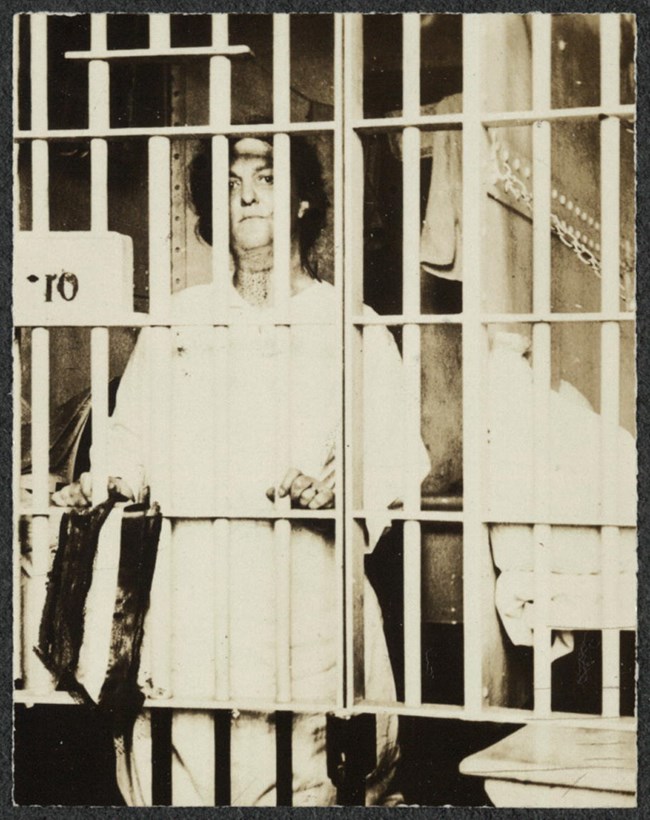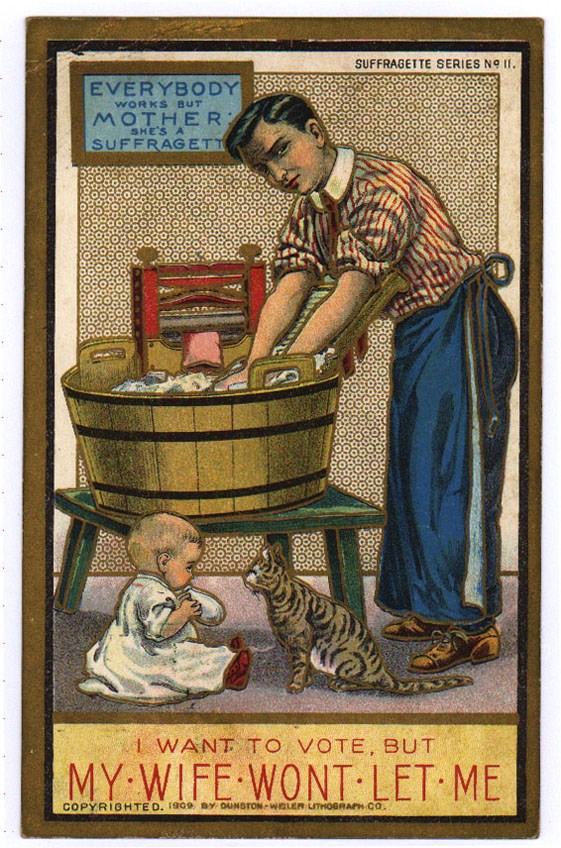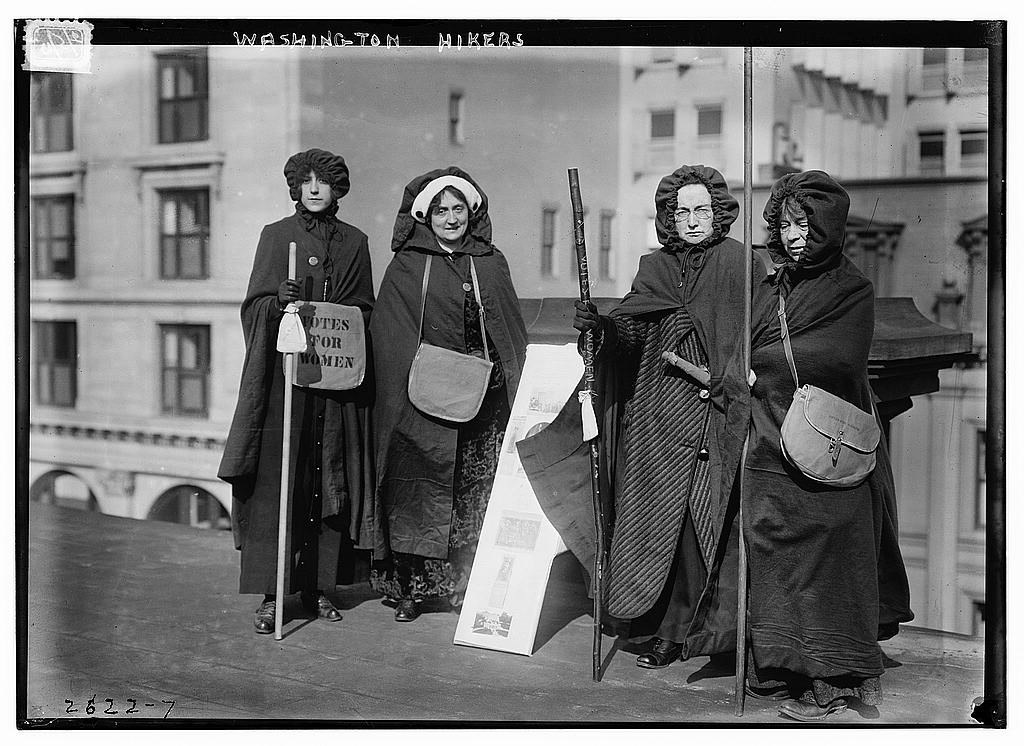Part of a series of articles titled Suffrage in America: The 15th and 19th Amendments.
Article
The Nineteenth Amendment
Where do social movements get their start?

Library of Congress, Records of the National Woman's Party
https://www.loc.gov/resource/mnwp.276016
During the United States’ early history, women were denied many of the rights enjoyed by men and faced discrimination because of their sex. Women were excluded from many jobs and educational opportunities. But because they did not have the right to vote (also known as suffrage), women were limited in terms of how much influence they could have over laws and policies. In addition, before the Civil War, many women participated in reform activities, such as the abolitionist movement and temperance leagues. They wanted to pass reform legislation to address the problems they saw in American society, but politicians would not usually listen to those who were disenfranchised (did not have the right to vote). Women’s frustration with their low status in society motivated them to create a movement that eventually resulted in the Nineteenth Amendment. This amendment says “The right of citizens of the United States to vote shall not be denied or abridged by the United States or by any State on account of sex.” That is, it prohibits discrimination in voting based on sex.

Library of Congress, Records of the National Woman's Party
https://www.loc.gov/item/mnwp000060/
Women first organized at the national level in July of 1848, when suffragists such as Elizabeth Cady Stanton and Lucretia Mott convened a meeting of over 300 people in Seneca Falls, New York. The attendees included early suffragists Martha C. Wright, Jane Hunt, and Mary M’Clintock, and abolitionist Frederick Douglass. These delegates discussed the need for better education and employment opportunities for women, and the need for suffrage. While there, Stanton wrote the Declaration of Sentiments, which is considered to be the founding document of the women’s rights movement.
The suffrage movement grew larger in the years following the Civil War. Women all across the United States participated in the effort to gain the right to vote, though they did not always agree on which strategy was best. Suffrage organizations formed to carry out a variety of tactics. Elizabeth Cady Stanton and her longtime collaborator, Susan B. Anthony, founded the National Woman Suffrage Association (NWSA), which focused on changing federal law and opposed the Fifteenth Amendment, which protected Black men’s right to vote but excluded women. Several people, including Lucy Stone and Julia Ward Howe, disagreed with Stanton and Anthony’s position on the Fifteenth Amendment, and formed a new organization: the American Woman Suffrage Association (AWSA). AWSA supported the Fifteenth Amendment and its members were both Black and white.

1909. Palczewski, Catherine H. Postcard Archive. University of Northern Iowa. Cedar Falls, IA.
The leaders of the movement tended to be educated, middle-class white women with money. They set the national agenda, which didn’t always reflect the experiences of all women. Working women and/or women of color experienced discrimination and prejudice not only because they were women, but also based on their class and race. Many Black women joined suffrage organizations that addressed their specific experiences. Leading reformers including Harriet Tubman, Frances E.W. Harper, Ida B. Wells, and Mary Church Terrell formed the National Association of Colored Women’s Clubs (NACWC) in 1896. The NACWC campaigned in favor of women’s suffrage and improved education, and fought against Jim Crow laws.
In 1890, Anthony helped reunite the NWSA and AWSA to form the National American Woman Suffrage Association (NAWSA). One member, Alice Paul, thought that the organization was too moderate, so she founded the National Women’s Party (NWP). The NWP had a variety of strategies to bring attention to the suffrage movement. Its members picketed the White House and held demonstrations in nearby Lafayette Park and at the U.S. Capitol and Senate office buildings. They participated in lobbying, nonviolent protests, hunger strikes, civil disobedience, and silent vigils. Street speaking, pageants, and parades were some of their more eye-catching actions. Alice Paul organized the largest suffrage pageant, which took place in Washington, D.C. on March 3, 1913. About eight thousand women marched from the Capitol to the White House, carrying banners and escorting floats. The 500,000 spectators watched the march, some in support. Others harassed and attacked suffragists in the parade; over 100 women were hospitalized with injuries that day. The parade was important, not only because of its size, but also because the participants challenged traditional ideas of how women should behave in public. They were loud, bold, and theatrical. Those who opposed women’s suffrage feared that society would suffer if women played a role besides wife or mother.

Library of Congress, Lot 11052
https://www.loc.gov/item/2014692437/

Library of Congress, Prints and Photographs Division https://www.loc.gov/resource/cph.3b49099/
Such opposition would eventually be overruled. In 1919, both the House of Representatives and the Senate passed the Nineteenth Amendment. The amendment then went to the states for ratification. Thirty-six states needed to ratify the amendment in order for it to be adopted, and Harry Burn in the Tennessee House of Representatives cast the decisive vote. Burn had planned to vote against the amendment, but changed his mind after his mother urged him to “be a good boy” and vote for ratification. On August 18, 1920, the Nineteenth Amendment went into effect.
On November 2 of that year, over eight million women voted in the U.S. election for the first time. Women also ran for political office in greater numbers. Jeanette Rankin was one of the few women to hold an office before the ratification of the Nineteenth Amendment. When she was elected to Congress in 1916, she made a prediction that would soon come to pass: “I may be the first woman member of Congress. But I won’t be the last.”
[Cited in Winifred Mallon, “An Impression of Jeannette Rankin,” The Suffragist (March 31, 1917).]
Consider This:
-
Who are the first leaders who come to your mind? What makes those people great leaders?
Last updated: October 9, 2020
